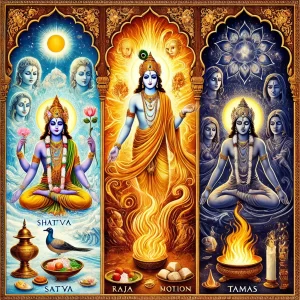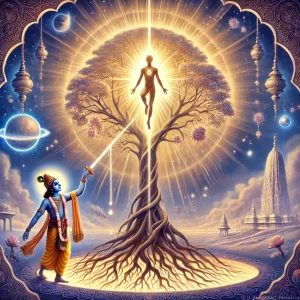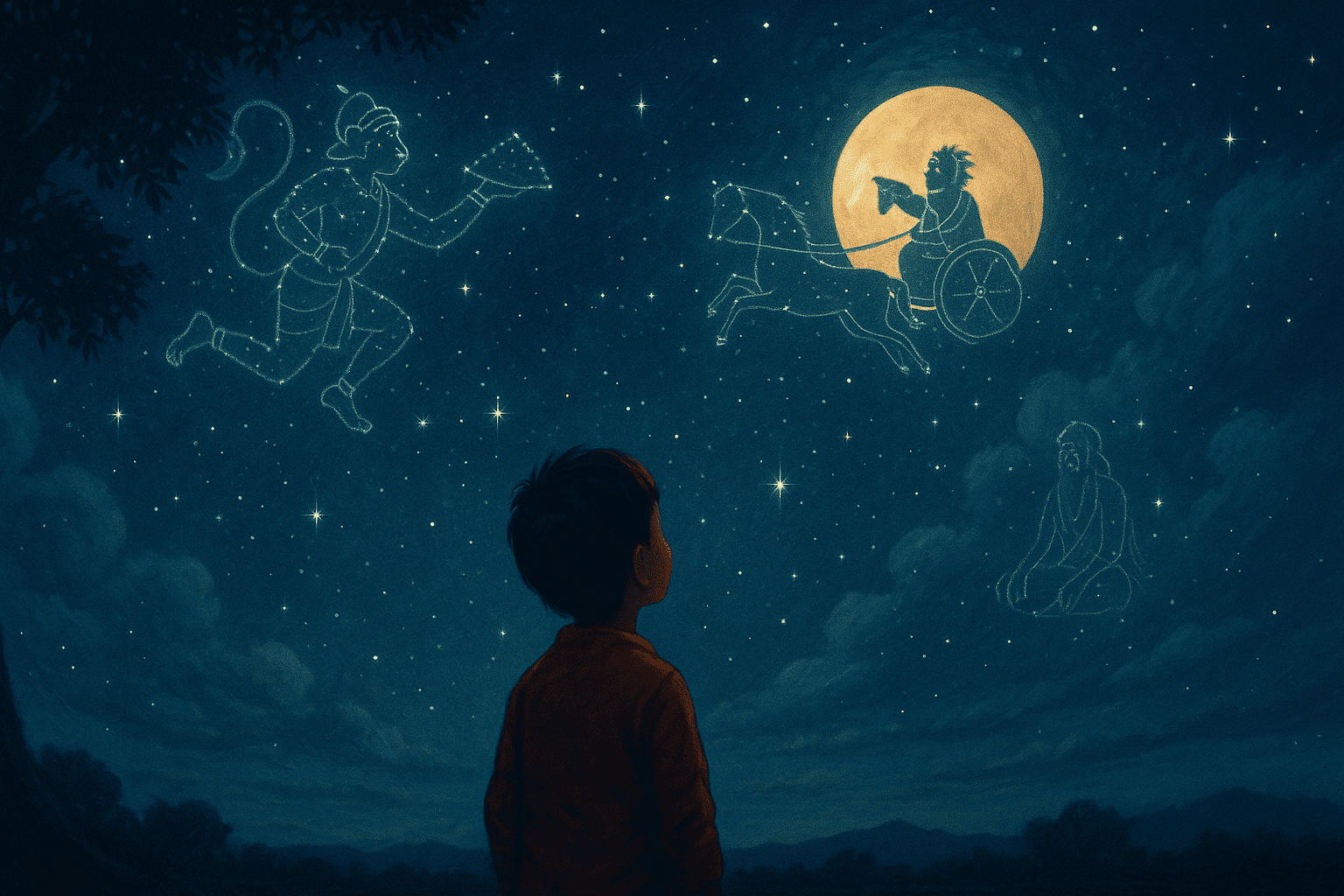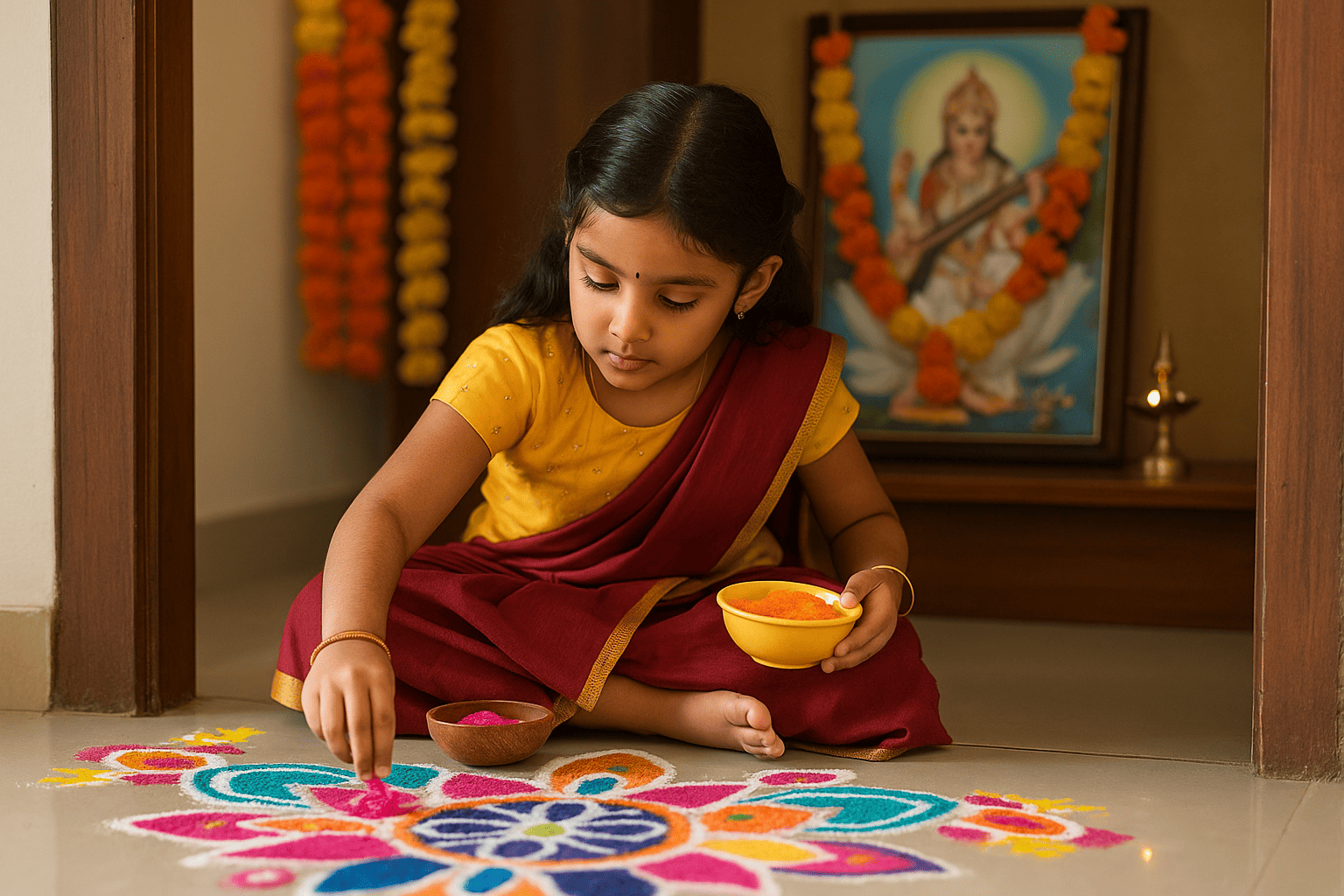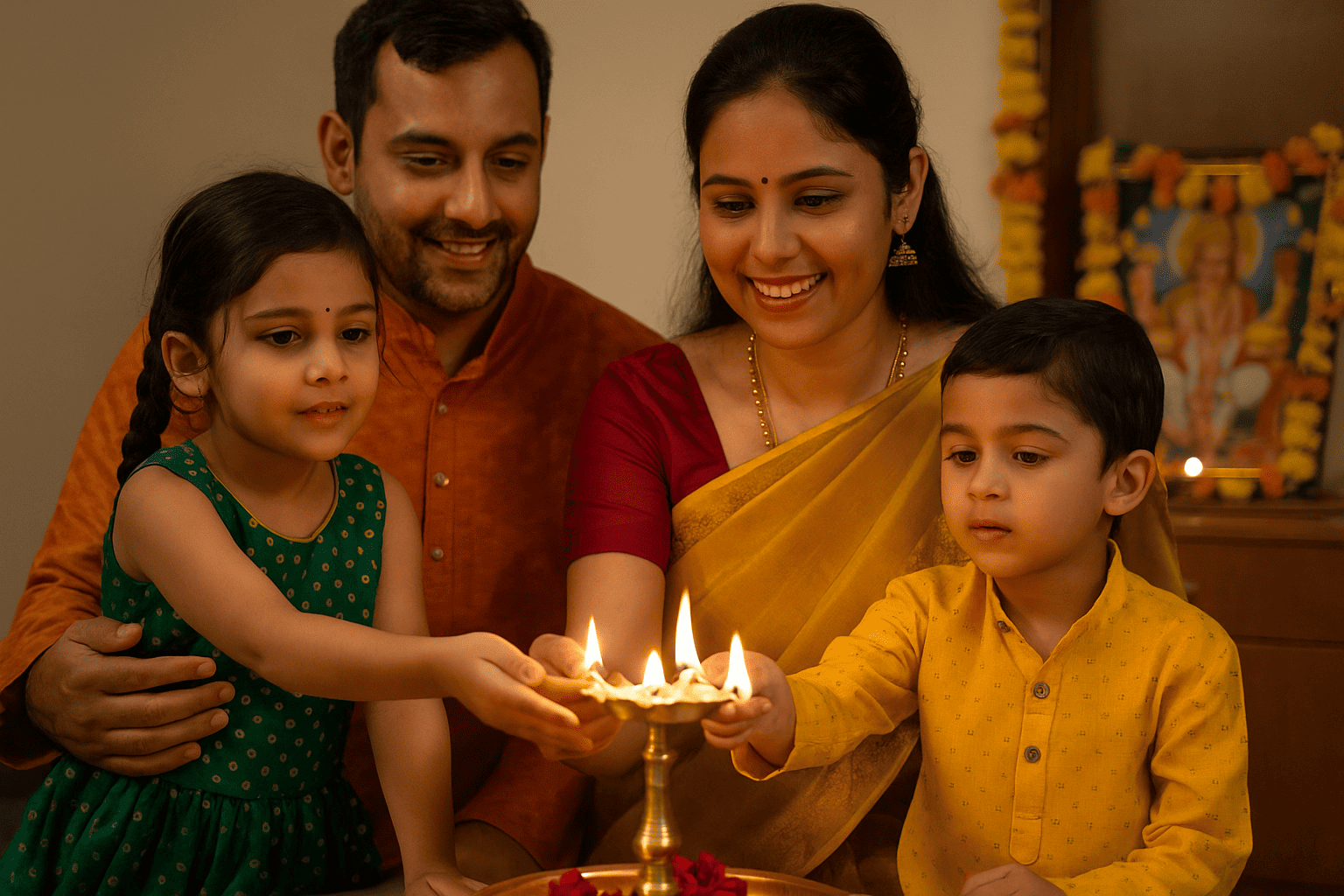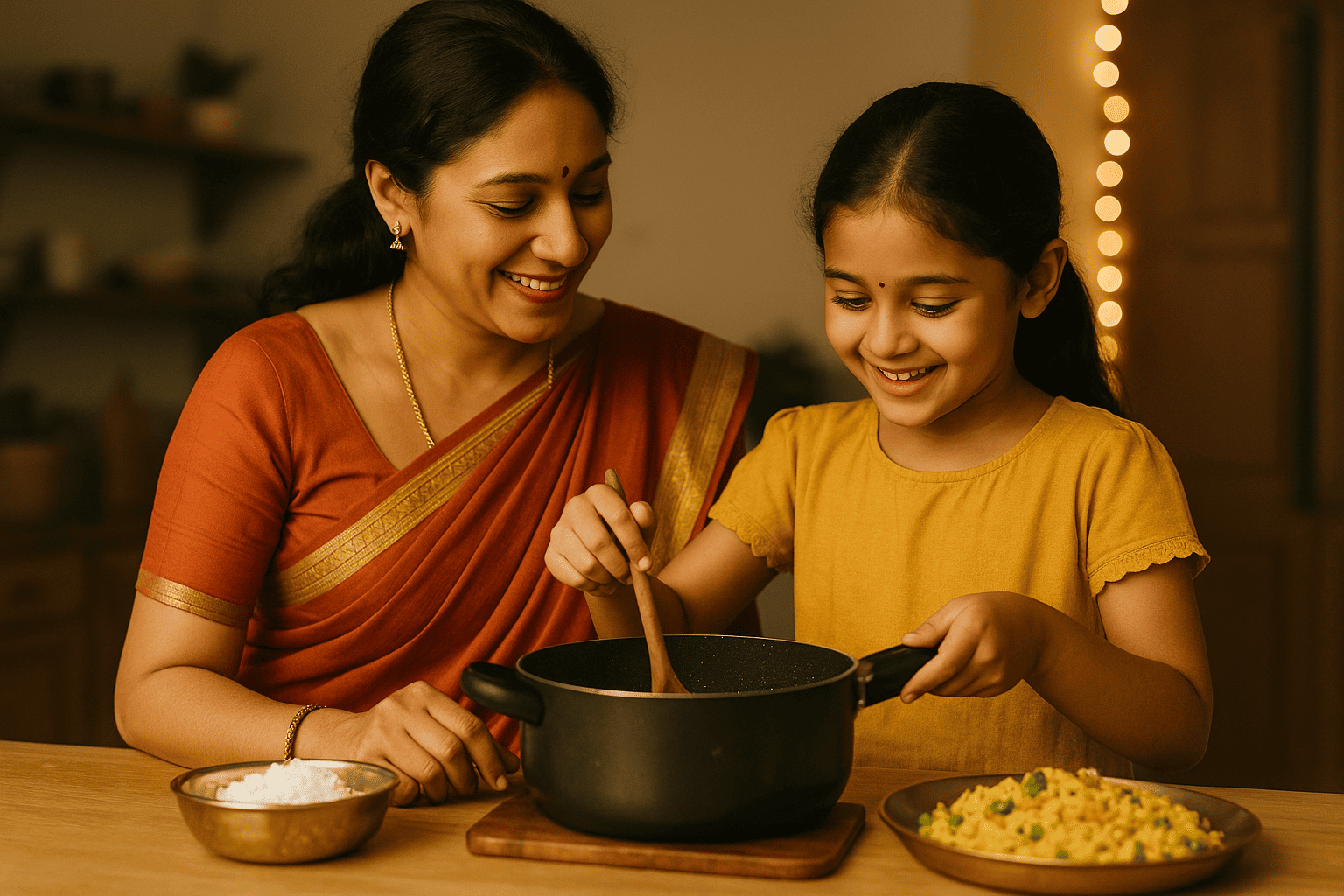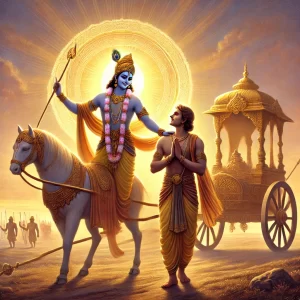
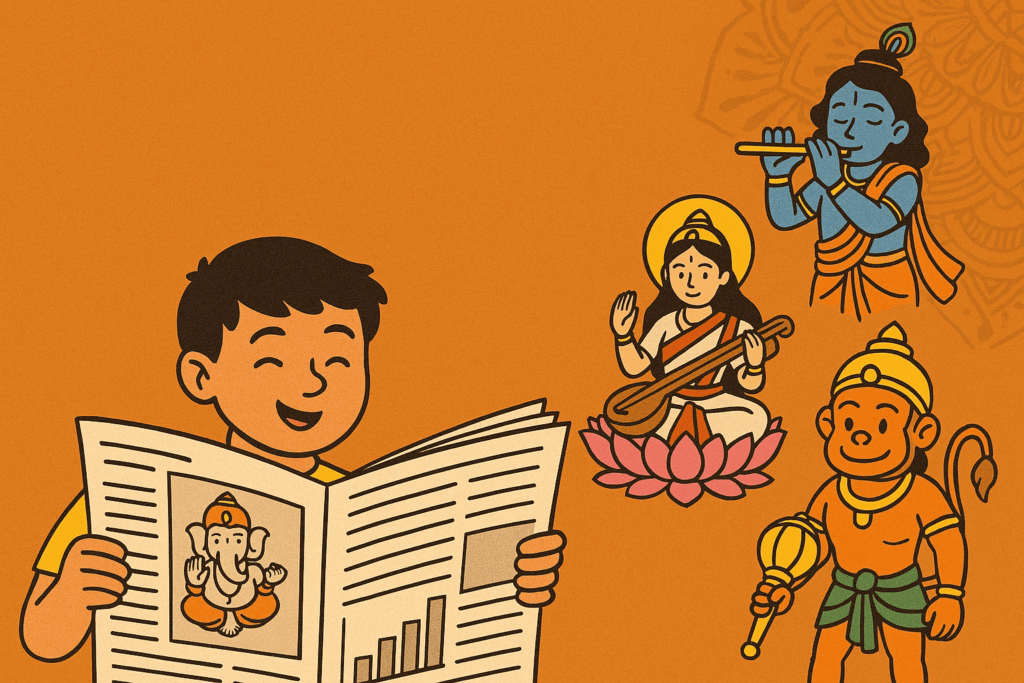
In a world buzzing with distractions, where information flows faster than ever, how do we make sure children still hear the quiet, wise whispers of their roots? How do we bring ancient stories, sacred symbols, and deep philosophies into a space where cartoons, games, and fast-paced reels dominate?
For many families, especially those navigating both tradition and modernity, this is an everyday question. The good news? We’re beginning to find some beautiful answers. And often, those answers begin with a story.
Let’s begin with a scene that might feel familiar. A quiet evening at home. The hum of a ceiling fan. The comforting scent of sambhar drifting from the kitchen. The soft creak of a chair as an elderly woman folds a stack of freshly laundered clothes with practiced ease.
In the center of the living room, nine-year-old Arjun sat cross-legged on the floor, his fingers moving rapidly across a tablet screen. He was deeply engrossed in a YouTube video—his eyes wide as Iron Man launched into the sky, Captain America threw his shield, and the Avengers saved the world once more. To him, it was a universe alive with power, loyalty, and glory.
His grandmother watched him quietly, the corner of her mouth lifting in amusement at his absorption. But her thoughts were elsewhere—drifting gently, like incense smoke, toward the stories she grew up with. Heroes of a different kind. She thought of Hanuman, leaping across oceans with the strength of devotion. She remembered Rama, whose unwavering commitment to truth shaped a kingdom. And Krishna, mischievous yet divine, whose flute once captivated not just gopis but generations of hearts.
She folded the last shirt and placed it neatly on the pile. Then, almost as if testing the waters, she asked in a soft, conversational tone, “Do you know who Bhima is?”
Arjun didn’t even glance up. “Is he in Marvel or DC?” he mumbled, his eyes still locked on the screen.
She laughed gently. Not at him—but at the sweet innocence of the question. Yet, inside, something quietly shifted.
Her smile lingered, but her heart dipped just a little. It wasn’t disappointment. It was something deeper. A subtle ache. A silent realization of how much the world had changed in just one generation.
That moment—the space between a grandmother’s memory and a grandson’s world—was real. Tangible. A gap not of love, but of language. Not just in words spoken, but in stories shared. A gap between what once was naturally absorbed through daily life and what now needs to be consciously introduced.
Arjun wasn’t wrong. He had grown up in a world where superheroes wore capes, not kavachams (armor). Where battles happened in galaxies, not on the fields of Kurukshetra. Where loyalty was measured in mission time, not in years spent in exile.
But what if he knew that Bhima, the mighty son of the wind god Vayu, could lift elephants with ease, defeat demons, and wield a mace with the force of thunder? What if he discovered that Bhima’s strength was not just physical—but moral, grounded in justice, loyalty, and righteous anger? What if he realized that his own culture had its heroes—flawed, human, courageous, and profound?
What if someone showed him?
Because that evening wasn’t just about a question or a forgotten name. It was about something deeper: the hunger for connection, even if it didn’t yet have a voice. It was about recognizing that children don’t reject tradition—they simply need to be invited into it, in a way that feels alive and relevant.
That invitation came to Arjun a few weeks later, not through a sermon, not through scolding—but through a story.
Folded neatly inside his school bag one day was a colorful weekly supplement from The Hindu In School. On its front page was an illustrated tale about Krishna and Sudama. Inside were crosswords about the Ramayana, a “Myth vs. Fact” segment on popular Hindu beliefs, and even a comic strip of Hanuman doing push-ups to build strength before his leap to Lanka.
Something about it clicked.
It wasn’t preaching. It wasn’t formal. It was fun. It met Arjun on his turf—with visual excitement, relatable humor, and gentle wisdom.
And just like that, a new chapter began. Not with fanfare, but with curiosity. Not with the sound of a temple bell, but with the quiet rustle of a turning page.
For centuries, Hinduism has been passed down through temple chants, grandmother’s tales, sacred verses, and rituals performed at home. But in today’s rapidly changing world—where screens light up faster than lamps and attention spans flicker like diyas in the wind—the challenge is no longer about what to pass on, but how to do it in a way that connects.
That’s where the transformation begins.
Reimagining Hinduism for children doesn’t mean simplifying it to the point of losing its soul. It means rediscovering it through the eyes of a child—curious, open, and ready to be amazed. It means offering the vastness of the Vedas, the rhythm of the Ramayana, and the grace of Ganesha in forms that feel relatable, playful, and alive.
At the heart of this reimagining lies what we call the Three E’s of Hinduism—Educating, Engaging, and Empowering. These aren’t just trendy buzzwords plucked from a marketing campaign. They are the lifelines of a tradition being retold for the next generation. They are bridges—not to cross over and leave the old behind, but to connect the sacred with the everyday.
Think of them as bridges between:
These bridges don’t stand alone. They are being built by teachers who weave festivals into school activities, by parents who mix bedtime stories with shlokas, and by publications like The Hindu In School, who have taken up the noble task of making heritage not only accessible—but exciting.
And now, it’s time we walk across those bridges together. Because what waits on the other side is not just a better understanding of the past—but a stronger, more confident future.
Hinduism is not a chapter in a textbook. It’s a universe.
It spans millennia, stretches across continents, and pulses with the collective wisdom of sages, poets, philosophers, kings, and everyday people. It’s woven into architecture, music, science, astronomy, dance, language, and cuisine. It’s not just a religion. It’s a way of seeing the world.
And that’s what makes educating young minds about Hinduism both a challenge and a beautiful opportunity.
You can’t distill it into bullet points. You can’t expect a child to fall in love with it through rote learning or thick scripture. Hinduism isn’t meant to be memorized. It’s meant to be experienced. To truly teach it, you need to awaken curiosity. You need to plant wonder.
It begins with a question. A very simple, innocent question like:
“Why does Ganesha have an elephant head?”
And if you’re lucky, the child follows it up with:
“What happened to his real head?”
“Why did Shiva cut it off?”
“Can gods make mistakes?”
Each of those questions opens the door to a deeper truth—not just about divine beings, but about forgiveness, identity, power, and transformation. And the answer isn’t a dry explanation. It’s a story. A tale filled with emotion, complexity, and a touch of mischief. A tale that a child can listen to a hundred times and still find something new.
That’s the art of educating through Hinduism—it’s not about lectures. It’s about listening together. It’s not about telling children what to believe, but inviting them into a story where they can find meaning for themselves.
Publications like The Hindu In School have mastered this delicate balance. They don’t dump facts. They build little doorways—through colorful pages, simple illustrations, and short, engaging write-ups—that help children step into ancient ideas in modern ways.
One week, the focus might be on karma—explained not as a cosmic reward-punishment system, but as a law of cause and effect, something that makes sense even in the playground: “If you help your friend today, they’ll likely help you tomorrow.”
Another week, it might be dharma—linked to everyday responsibilities, like brushing your teeth or being kind to your sibling, as part of your mini dharma.
Festivals are a perfect entry point. But instead of stopping at sweets and new clothes, these stories dig deeper. Why do we light lamps during Deepavali? Why do people in Tamil Nadu celebrate the victory of Krishna over Narakasura while in North India it’s about Rama returning to Ayodhya? Why does Saraswati hold a veena, and why do we place books at her feet?
When children are introduced to these concepts through stories, questions, puzzles, and discussions, something remarkable happens—they begin to internalize the learning without even realizing it. It’s not “religious education” in the traditional sense. It’s cultural exploration. It’s like taking a journey into your roots with a backpack full of crayons, curiosity, and joy.
Imagine a classroom where the teacher says, “Today we’re going to explore the ten avatars of Vishnu—and for homework, draw what you think the eleventh avatar could be!” Suddenly, it’s not just about the past. It’s about imagination, creativity, and ownership of tradition.
And that’s the magic of it all.
Educating children about Hinduism is not about preparing them for exams or rituals. It’s about giving them a lens through which to see the world. It’s about offering them the richness of their heritage in a language they understand—a language of stories, symbols, values, and wonder.
Because when a child learns why Ravana was brilliant but still fell, or how a squirrel helped Rama build a bridge to Lanka, they’re not just learning mythology. They’re learning that every action counts, that pride has consequences, and that even small beings can do great things.
That’s not just education.
That’s awakening.
A great story doesn’t just teach—it transports.
Close your eyes and imagine this: You’re ten years old, sitting cross-legged with a book in your lap. You turn the page and find yourself staring at an image of a blue-skinned boy—barefoot, smiling, and effortlessly lifting an entire mountain above his head like an umbrella. Around him, villagers huddle, protected from storm and flood. The boy? Krishna. The mountain? Govardhan.
That single image—simple yet profound—does something. It imprints itself into your memory. It stirs something inside you. Long after you forget the text or the quiz you took in school that day, that story remains. Because in that moment, you weren’t just reading—you were feeling. You were there, under the mountain, looking up in awe.
That is the power of engagement.
And in the context of Hinduism, engagement isn’t about reducing the tradition to cartoons or entertainment. It’s about inviting children to step inside the story. It’s about emotional connection. About creating a space where the divine doesn’t feel distant, but familiar. Where the gods don’t just reside in temples—they play, laugh, struggle, learn, and grow—just like the children reading about them.
The way Hindu stories are being presented today has undergone a gentle revolution.
Gone are the days when a single, black-and-white picture book with stiff language and faded images had to bear the burden of passing on centuries of culture. Today, children can experience the tradition in a language they understand—in formats that feel alive, exciting, and personal.
This form of engagement is powerful because it doesn’t start with instruction. It starts with invitation. Children are not told, “This is what you must believe.” Instead, they are asked, “What do you think?” That single shift turns passive listeners into active participants. It helps children form a relationship with their culture, not out of obligation—but through curiosity, joy, and emotional resonance.
And this engagement has a ripple effect.
Parents have begun to notice something remarkable. A child who reads about Hanuman doesn’t just keep it to themselves. They start telling their siblings. They start acting it out. One moment, they’re tying a scarf around their shoulders, pretending to fly. The next, they’re retelling the story in their own words at the dinner table.
Siblings begin playing “Ramayana” instead of hide-and-seek. One plays Sita, one plays Ravana, another is the heroic monkey. Friends begin sharing how their families celebrated Navaratri differently this year. A classroom begins discussing why Krishna always seems to be smiling, even during the most intense battles. The stories spark questions, and the questions spark conversations.
What starts as a comic strip or activity in a school supplement becomes something far more meaningful—a shared language of connection.
This is when the real magic of engagement happens—when stories leave the page and enter the home, the classroom, the playground. When tradition is no longer confined to the four walls of a temple visit or the corner of a pooja room, but begins to live and breathe in everyday moments.
And perhaps most importantly, this kind of engagement allows children to make space for these stories in their own imagination. They don’t feel the need to choose between Krishna and their favorite superhero, or between their schoolwork and a festival. Instead, they start weaving both together, creating a blended identity that feels natural and strong.
Because when stories come alive, they don’t just teach—they become part of who we are.
Let’s return to Arjun—the curious, wide-eyed boy who once asked if Bhima was from Marvel or DC.
It had been a few months since he first brought home The Hindu In School supplement, and something had subtly shifted in him. He was still the same boy who loved superheroes and sketching in the margins of his notebooks. But now, those sketches sometimes included a mace-wielding Hanuman alongside Captain America, or a thoughtful Krishna playing the flute beside Spider-Man. In his world, the divine and the mythical didn’t compete—they coexisted.
Then came a school competition. The theme: “What does your culture mean to you?”
One by one, his classmates stood up to share their answers. Some spoke about their favorite dishes during festivals, some described the colorful clothes they wore for family events, and others shared stories of holidays spent in their grandparents’ homes. All beautiful, all heartfelt.
And then it was Arjun’s turn.
He stood up, holding a slightly crumpled sheet of paper, and began:
“My favorite superhero is Hanuman. He’s strong, kind, and brave. He helps people—even when they don’t know he’s there. He never gives up. And I think that’s what my culture teaches me too—to be brave, to help others, and to always try my best.”
The room fell silent for a moment.
That wasn’t just a speech. That was empowerment in action.
Because true empowerment happens when a child doesn’t just know their heritage—they own it. When they don’t repeat facts to impress someone else, but speak from a place of connection and pride.
Empowerment is what happens when a child no longer sees their traditions as something separate or strange—but as something intrinsically theirs. When they understand why their family lights lamps at dusk, why their parents fast on certain days, why their names have meanings rooted in Sanskrit, Tamil, or Bengali—it becomes a source of strength rather than confusion.
This is especially powerful for children growing up in multicultural, global environments—where fitting in often feels more important than standing out. For many Indian-origin children living abroad, heritage can sometimes feel like a burden. Something that makes them “different” from their peers. Something they can’t quite explain at school or see reflected in their media.
But that narrative begins to shift the moment they see themselves represented.
The moment they open a children’s book and find a Tamil girl performing a Karthigai Deepam ritual with her grandmother. Or when a Singaporean boy hears a podcast explaining Raksha Bandhan—not just as a “festival with threads,” but as a celebration of trust, love, and protection between siblings.
These stories say, “You matter. Your culture matters. Your story is part of a bigger, beautiful whole.”
They remind children that they are not alone in their experiences. That millions of other young hearts are learning, growing, and asking the same questions. They help a child see themselves not as a cultural outsider, but as a torchbearer of a legacy that stretches far behind and far ahead.
And with that awareness comes confidence.
Confidence to share. To celebrate. To question. To explore. To explain their culture to others without shame or fear. To walk into the world carrying not just academic success or extracurricular medals—but a deep-rooted sense of self.
Because when a child understands the stories that shaped their ancestors, when they feel the rhythm of their prayers and the meaning behind their festivals, they begin to walk taller. They begin to feel a quiet pride, the kind that doesn’t shout, but shines.
They start to say, with clarity and conviction:
Childhood today is a whirlwind.
Our children grow up in a world where information comes in flashes, entertainment never pauses, and silence is rare. Their minds are constantly pulled in a dozen directions—school, screens, social media, peer pressure, academic expectations. They learn fast, speak fast, move fast—but in all this speed, something sacred risks being lost.
That something is stillness, depth, and identity.
In this hyper-connected, often overwhelming world, many children grow up knowing more about global pop culture than their own family traditions. They can quote movie lines, sing trending tunes, and navigate apps better than adults—but when asked about their heritage, they often hesitate. Not because they don’t care—but because no one showed them that their roots could be as rich, exciting, and meaningful as anything else in the world.
This is where Hinduism gently steps in—not as a commandment, not as a lecture, but as a quiet companion. It brings with it stories that don’t demand perfection, but celebrate perseverance. Characters who don’t just win battles, but overcome inner struggles. A worldview that says: you are already divine, you just need to remember it.
Hinduism doesn’t teach in straight lines. It teaches in spirals—through parables, symbols, festivals, and shared rituals. It doesn’t ask children to believe blindly, but to experience and explore. It offers:
But here’s the truth: if we want our children to receive this wisdom, we must meet them where they are.
And where they are… is in a world of comics, interactive media, bite-sized learning, and story-driven experiences.
This is why the Three E’s—Educating, Engaging, and Empowering—matter more now than ever before.
These aren’t strategies. They’re emotional currents. When education becomes a story, learning feels like a discovery. When engagement feels like play, faith becomes fun. And when empowerment is nurtured through understanding, identity takes root—not as something to defend, but as something to cherish.
Imagine a child who understands that Diwali is not just about sweets and sparklers, but about inner light triumphing over darkness. Imagine a child who reads about Arjuna’s doubts and sees their own fears reflected—and resolved. Imagine a child who doesn’t feel “different” because of their name, their pooja shelf at home, or their temple visits—but instead, feels special because of it.
When we raise children with both modern confidence and cultural grounding, we’re not just giving them tools for school. We’re giving them tools for life.
They begin to look inward, to ask deeper questions. They begin to take pride in their roots. And slowly, they begin to carry those roots forward—not as a burden, but as a torch.
Because when a child knows who they are, the world cannot shake them.
At the heart of Hinduism lies something timeless—not just a collection of rituals or doctrines, but a living narrative that continues to unfold with each generation. Hinduism is not confined to dusty palm-leaf manuscripts or echoing temple halls. It doesn’t live only in ancient Sanskrit shlokas or ornate idols. It thrives wherever there is life. It flows through the everyday—in how we speak to our elders, in how we treat a guest, in how we light a lamp during twilight or pause for a prayer before a test.
It is a story told at a grandmother’s knee. A story heard in a bhajan playing softly on the radio during a car ride. A story glimpsed in a kolam drawn at dawn. A story felt in the aroma of pongal on a festival morning. It is written in our gestures, in our greetings, in the symbols we wear, and the questions we ask.
And now, more than ever, it lives in our children’s hearts—thanks to the quiet revolution led by teachers, parents, illustrators, authors, curriculum designers, and storytellers who are brave enough to rethink how tradition is shared. People who understand that the most powerful way to pass on something sacred is not through fear, guilt, or obligation—but through joy.
Yes, joy.
Because when a child laughs at a tale of Ganesha outsmarting his brother, or marvels at the idea of a river goddess blessing a land, or colors in a picture of Nataraja mid-dance, they are not simply “learning religion.” They are building a relationship—with themselves, with their ancestry, and with something larger than life that still feels deeply personal.
Take Arjun, for example—the curious boy who once mistook Bhima for a Marvel character. Today, his sketchbook is full of worlds colliding. On one page, Batman broods over Gotham. On the next, Hanuman soars above Lanka with the Sanjeevani mountain. To him, they are both heroes—both brave, both loyal, both trying to do the right thing. He no longer sees a line dividing tradition from imagination. He sees possibility.
And this is the future we hope to build—not a generation that has to choose between ancient and modern, East and West, tradition and trend—but one that understands they can carry both. That their roots don’t weigh them down; they anchor them. And from that grounding, they can rise, dream, question, and create.
Because Hinduism isn’t a story with a beginning, middle, and end. It’s a story that spirals outward—growing, adapting, evolving with each storyteller. With every child who listens and retells, with every drawing, every festival celebrated with new meaning, every question asked with wide eyes and an open heart.
So here we are. At a beautiful turning point. On a bridge between generations.
And walking across that bridge is a new generation—not walking away from tradition, but toward it. Not with blind faith, but with eyes wide open, hands eager to create, and hearts ready to belong.
And the story? It goes on.

